.png)
ON THIS PAGE
Stay Updated with latest in AI SEO
21 November 2025
Most product pages fail AI visibility tests because they list features instead of solving problems. The solution requires: 1) Problem-solution mapping for specific customer types, 2) Comparative context explaining advantages over alternatives, and 3) Authority signals with measurable outcomes. Implementation typically takes 2-4 weeks with results visible within 30-60 days.
Analysis of e-commerce product pages reveals a significant gap in AI visibility. While traditional search optimization focuses on keyword targeting and technical SEO, language models evaluate content based on problem-solving clarity and contextual relevance.
Current visibility challenges include:
Why This Impacts Revenue
When potential customers ask AI systems "What's the best foundation for sensitive skin?" or "Which running shoes prevent knee pain?" they represent high-intent purchase opportunities. These queries indicate active buying mode, not casual research. Without AI visibility, these sales opportunities transfer to competitors with optimized presence.
The fundamental issue: product pages optimized for human browsing and traditional search often lack the problem-solution mapping that language models need for confident product recommendations.

Typical approach:"Anti-Aging Serum - Contains retinol and hyaluronic acid. Reduces fine lines and wrinkles. Suitable for all skin types. Apply nightly for best results."
AI-visible approach:"Gentle Retinol Serum for Sensitive Skin Beginners - Specifically formulated for women over 35 with reactive skin who want anti-aging benefits without irritation. The encapsulated 0.25% retinol releases gradually over 8 hours, preventing the irritation spike that causes sensitive skin users to abandon retinol treatments."
Language models understand and recommend solutions to specific problems rather than generic feature lists. The difference lies in problem specificity and outcome clarity.
Generic approach: "Premium running shoes with advanced cushioning technology and breathable design."
Contextual approach: "Marathon training shoes engineered for runners building endurance from 10K to 26.2 miles who need maximum impact protection to prevent overuse injuries. The responsive foam midsole may reduce joint stress compared to traditional running shoes, while the structured heel counter helps prevent overpronation commonly associated with IT band syndrome in distance runners."
Specific use cases and measurable benefits typically outperform generic quality claims in AI recommendation systems.
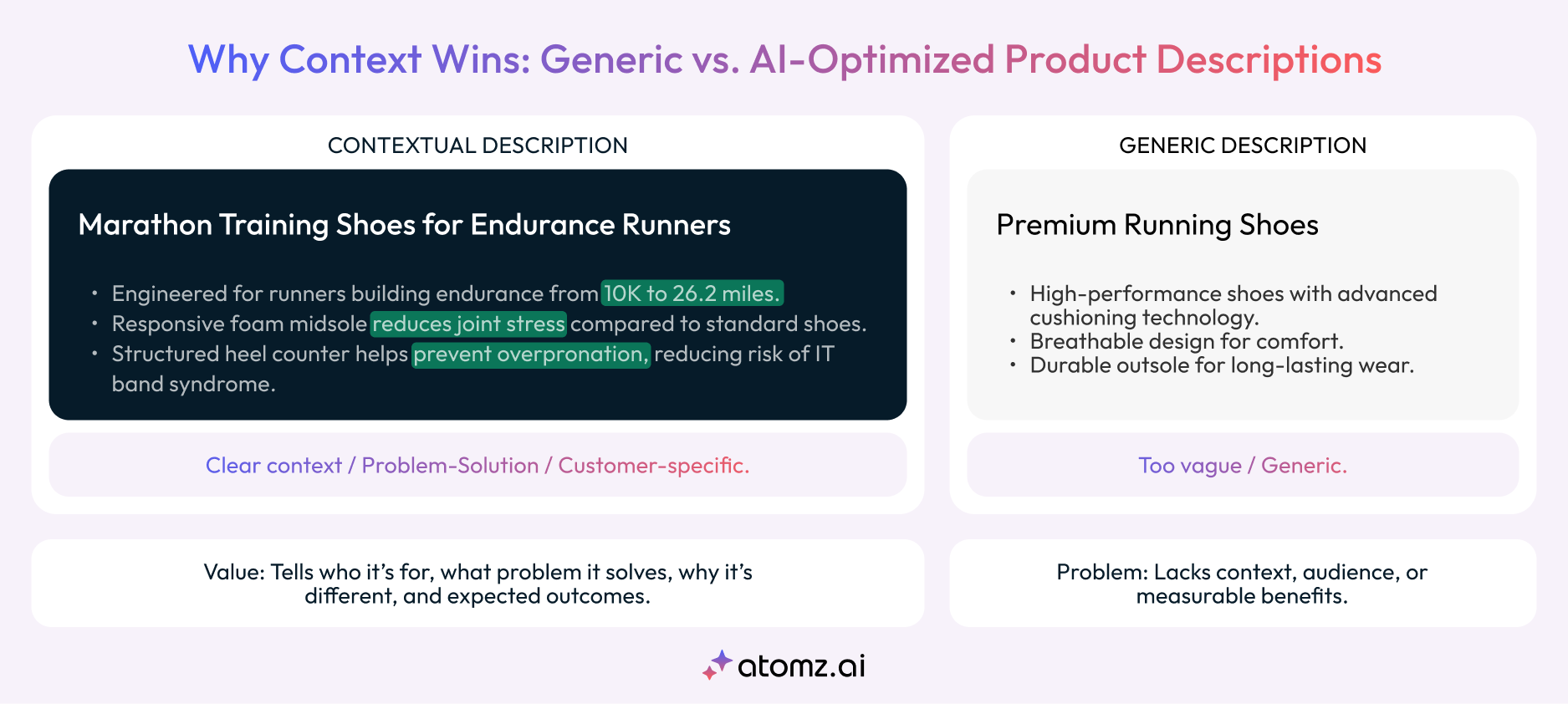
Language models excel at matching products to specific customer needs. Without clear context about target users, products become invisible in relevant recommendation scenarios.
Essential context elements:
Fashion brand transformation example:
Before: "Comfortable work blazer in navy and black. Professional styling with stretch fabric."
After: "Structured blazer designed for working mothers who need professional pieces that survive daily challenges including daycare pickup and long workdays. The wrinkle-resistant ponte fabric maintains sharp lines through various activities, while hidden stretch panels accommodate body changes without sacrificing professional appearance."
AI systems frequently help users choose between options. Products without explicit comparison context remain invisible in competitive evaluations.
Athletic wear example:
Without comparison: "High-performance workout leggings with moisture-wicking fabric."
With comparison: "Unlike cotton leggings that may become transparent during exercise or synthetic blends that can trap odor, these workout leggings use bamboo-fiber technology that typically maintains opacity during movement while naturally resisting bacterial growth. While some premium brands prioritize softness over durability and others focus primarily on moisture-wicking, this design attempts to balance opacity, odor resistance, and comfortable compression."
Transformation approach for skincare:
Generic version: "Hydrating face moisturizer for dry skin. Contains ceramides and hyaluronic acid."
Narrative-rich version: "Sarah, a marketing executive, experienced tight, flaky skin that appeared dull in video calls and felt uncomfortable under makeup. After switching from her previous gel moisturizer to this ceramide-rich formula, her skin typically stays hydrated for 12+ hours without feeling greasy, foundation applies more smoothly, and mid-day moisturizer reapplication became unnecessary during long meeting schedules."
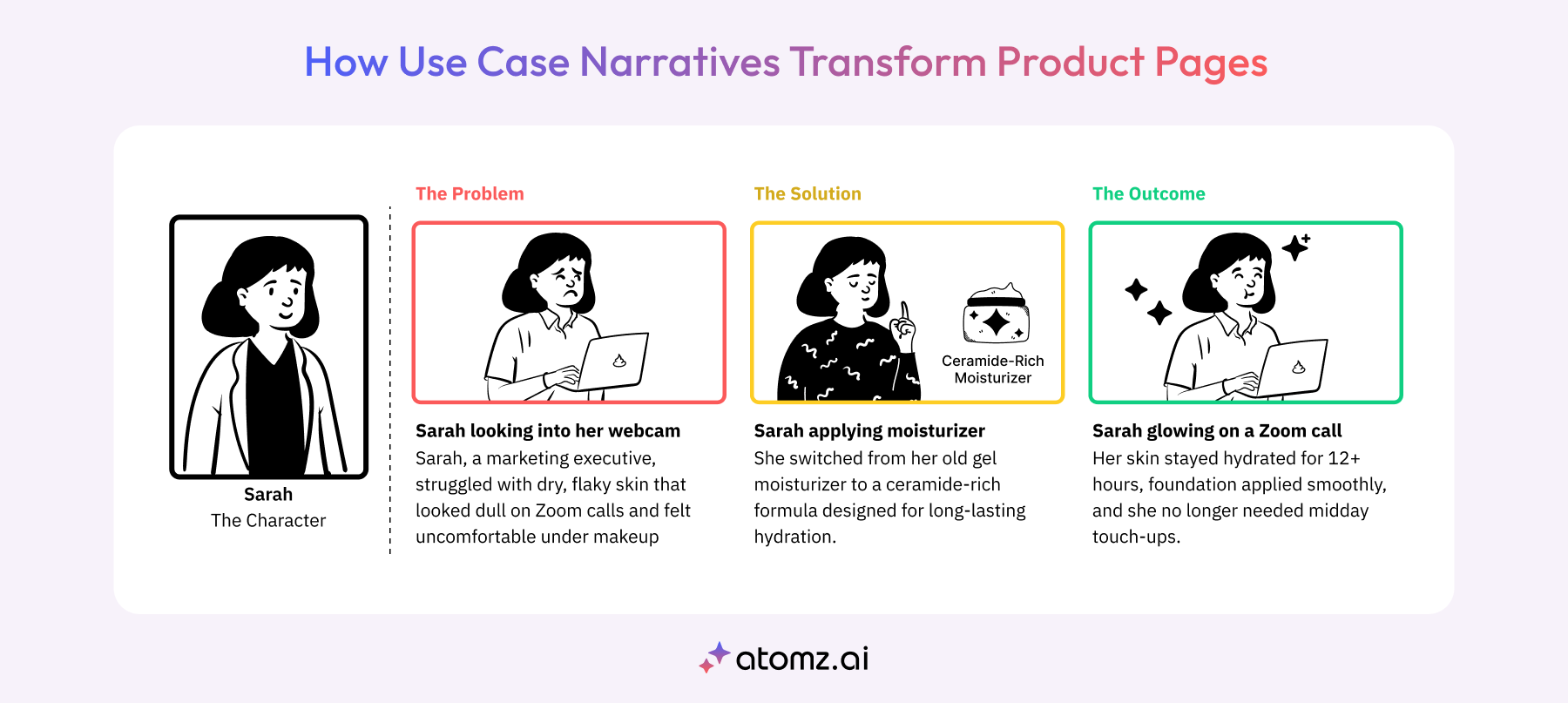
Effective framework structure:
Beauty brand implementation:
Problem: Women with oily, acne-prone skin struggle to find foundation that doesn't oxidize or potentially clog pores by midday.
Root Cause: Many foundations use comedogenic ingredients and aren't pH-balanced for acne-prone skin.
Traditional Solutions: Oil-free foundations often provide limited coverage, while full-coverage options may exacerbate breakouts.
Our Solution: Mineral foundation using zinc oxide and titanium dioxide with salicylic acid, pH-balanced at 5.5.
Expected Outcome: Clear skin maintenance with coverage that typically lasts 8+ hours without oxidation, though individual results may vary.
Elements that build AI trust:
Implementation example:"Developed in partnership with Dr. Sarah Johnson, Board-Certified Dermatologist specializing in acne treatment. Clinical testing on 200 participants with sensitive, acne-prone skin showed an average 70% reduction in new breakouts within 6 weeks, according to study data. Certified by the National Eczema Association as suitable for reactive skin types."
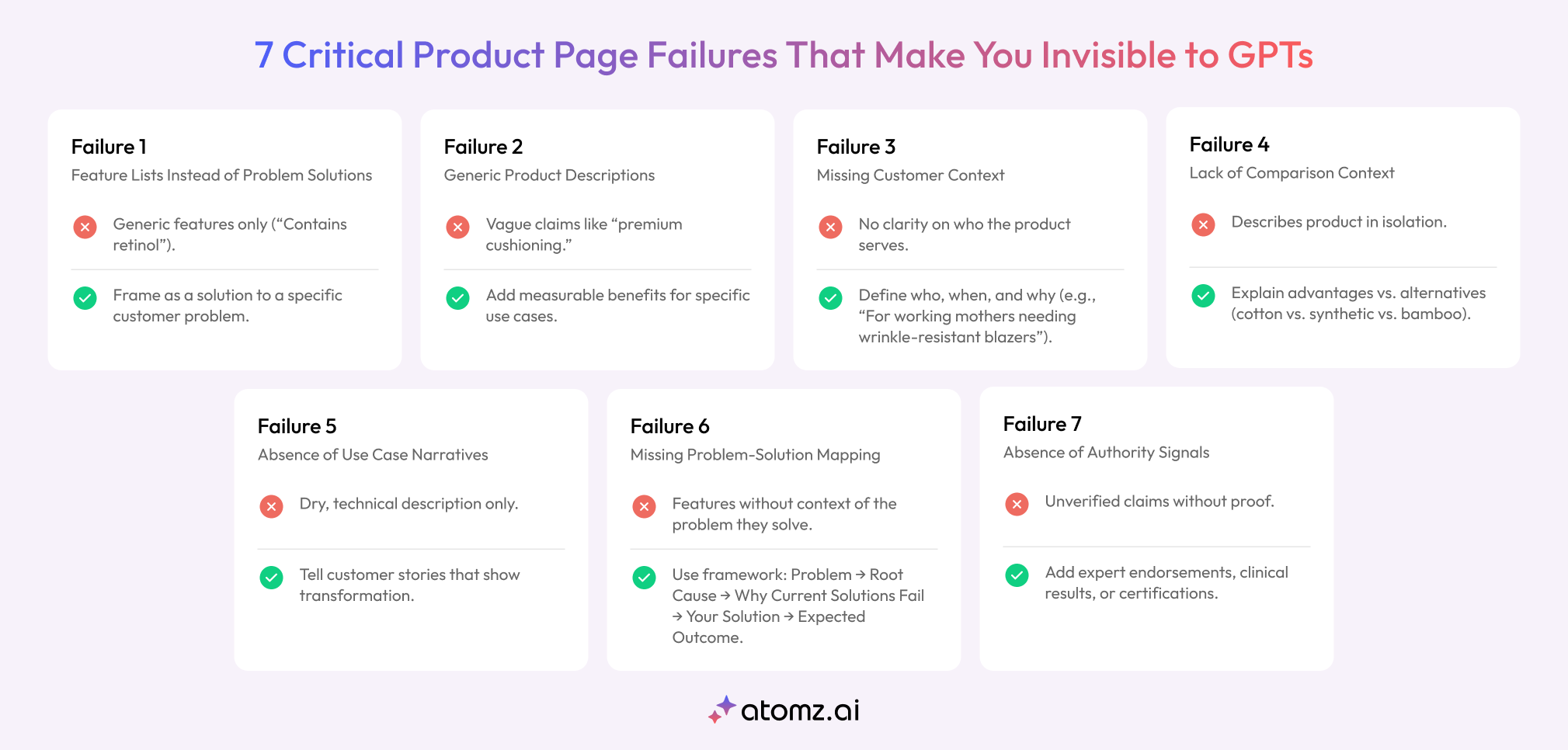
Traditional structure: Product name plus basic descriptionAI-optimized structure: Problem statement plus target customer plus unique solution
Template approach:"[Product Name] for [Specific Customer Type] who [Specific Problem/Need]. [Detailed explanation of who this serves and what specific problem it addresses, including context about when someone might need this solution]"
Traditional approach: Features and benefits listAI-optimized approach: Explicit comparison with alternatives
Template structure:"Unlike [Alternative A] that [limitation] or [Alternative B] that [different limitation], this [product] [specific advantage] because [technical/design reason]. This makes it particularly suitable for [specific use cases] where [specific benefit matters most]."
Traditional approach: General product descriptionAI-optimized approach: Specific customer scenarios
Template framework:"[Customer type], a [demographic details], was experiencing [specific problem]. After [time period] using [product], they typically experienced [specific outcomes] and reported [current satisfaction state]."
For additional guidance on narrative optimization, see Prompt Writing Techniques.
Traditional approach: Ingredient or material listAI-optimized approach: Explanation of how technical features address specific problems
Template structure:"The [technical feature] works by [mechanism] to address [specific problem]. This becomes particularly important for [target customer] because [why this matters specifically to them]."
Traditional approach: Generic testimonialsAI-optimized approach: Specific, verifiable social proof
Template framework:"[Expert name], [credentials], recommends this for [specific situation] because [expert reasoning]. [Customer name], [relevant context], typically reports [specific outcome] after [timeframe], though individual results may vary."

Traditional invisible description:"Versatile black dress. Comfortable fit. Perfect for any occasion."
AI-visible description:"Sheath dress designed for executive women who attend client dinners after full workdays. The ponte fabric resists wrinkles during long meetings, while three-quarter sleeves and midi length work appropriately for both boardroom presentations and evening networking events. Unlike typical work dresses that require layering, the structured design looks polished solo with statement jewelry for dinner, or professional with a blazer for day meetings."
Key optimization elements:
Traditional invisible description:"Anti-aging night cream with peptides and retinol. Reduces wrinkles and improves skin texture."
AI-visible description:"Night treatment specifically formulated for women over 40 with sensitive skin who want anti-aging benefits without irritation. The 0.1% encapsulated retinol combined with peptides works overnight to potentially stimulate collagen production, while ceramides help prevent the dryness that typically accompanies retinol use. Unlike some department store anti-aging creams that rely on higher concentrations, this gentle formula allows consistent nightly use without the cycle of irritation and recovery that can disrupt anti-aging progress."
Key optimization elements:
For comprehensive beauty optimization strategies, explore Product Pages Invisible to GPTs.
Traditional invisible description:"High-performance running shoes with responsive cushioning and durable construction."
AI-visible description:"Trail-to-road running shoes engineered for runners who split training between technical trails and pavement, particularly those training for obstacle races or varied-terrain events. The hybrid outsole provides traction on loose dirt and rocks while maintaining efficiency on asphalt, while the rock plate protects feet during technical descents without adding weight that might slow road pace. Unlike pure trail shoes that can feel cumbersome on pavement or road shoes that may slip on trails, these adapt to surface changes within single runs."
Key optimization elements:
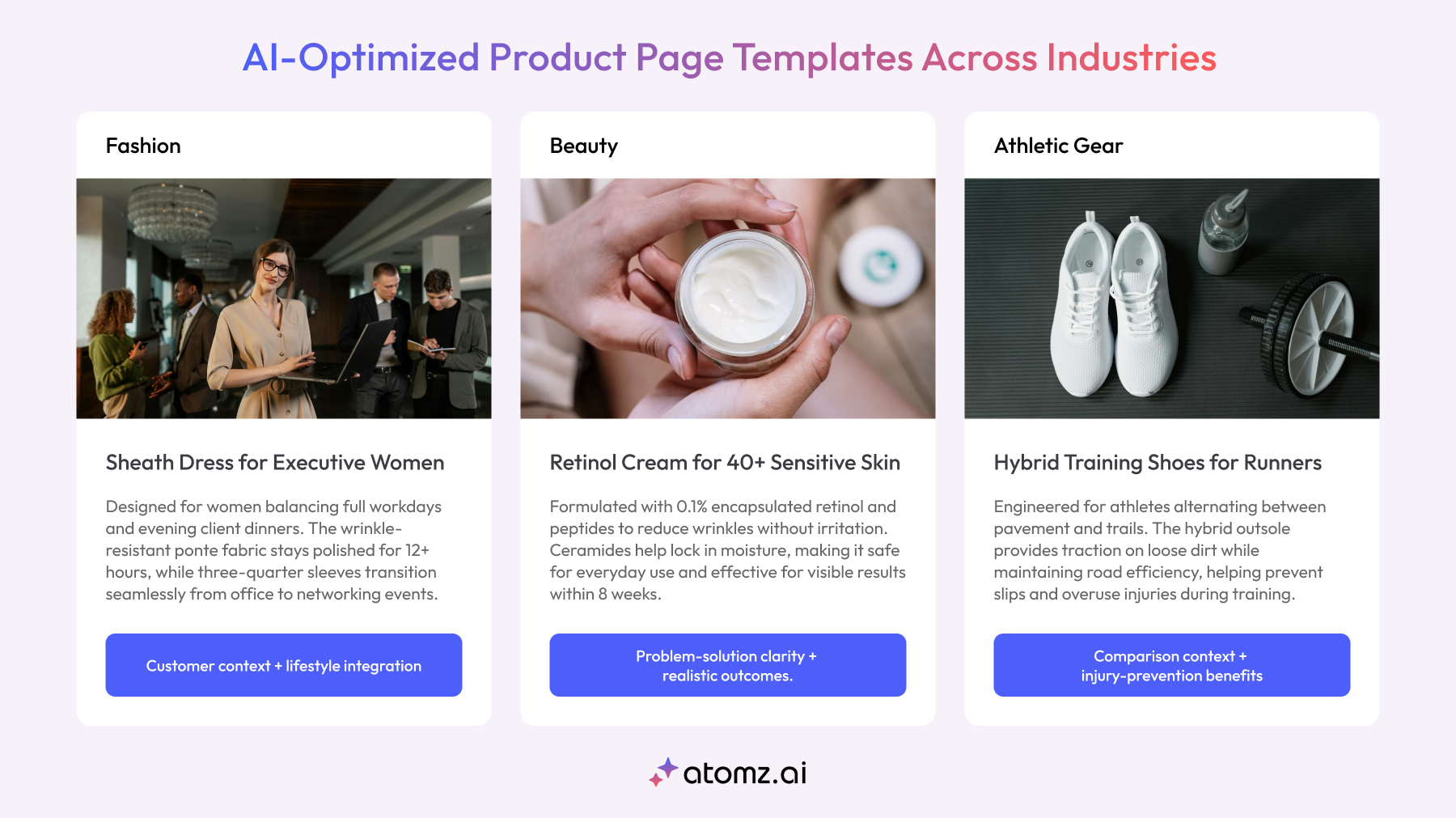
Instead of relying solely on structured data, use natural language that explicitly states relationships:
<div class="product-context">
<p>This anti-aging serum is specifically designed for women over 35 with
sensitive skin who are new to retinol. The gentle 0.25% concentration
helps prevent the irritation that causes many people to discontinue retinol
treatments, while potentially delivering visible results within 8 weeks
of consistent use.</p>
</div>
<section class="problem-solution">
<h4>Addresses: Foundation Oxidation in Oily Skin</h4>
<p>Problem: Foundation may look perfect in the morning but can turn
orange and separate by midday, especially in the T-zone area.</p>
<p>Why it happens: Many foundations aren't pH-balanced for oily skin's
natural acidity, potentially causing color shifts when they mix with sebum.</p>
<p>Our solution: pH-balanced mineral foundation designed to maintain
color consistency for 12+ hours, even on oily skin types.</p>
</section>
<div class="customer-story">
<h4>Ideal for: Working Mothers Transitioning Back to Office</h4>
<p>Jenny, a marketing manager returning to office work after remote years,
needed blazers that looked professional on video calls but moved comfortably
during busy days juggling meetings and school pickup. These stretch ponte
blazers maintain structured shoulders for professional appearance while
allowing full range of motion for active parenting demands.</p>
</div>
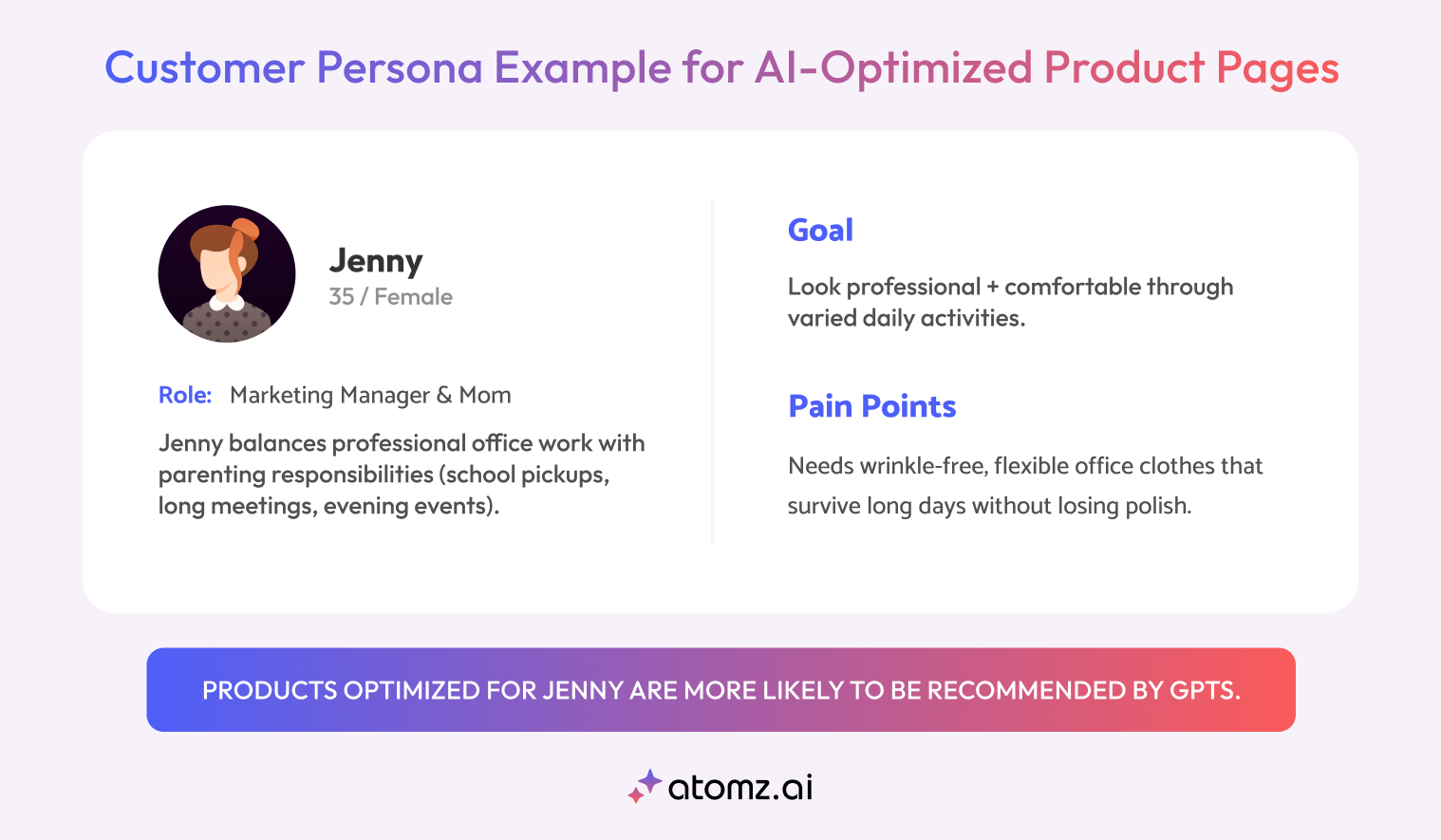
<section class="comparison-context">
<h4>How This Differs from Popular Alternatives</h4>
<ul>
<li><strong>vs. Liquid Foundation:</strong> Less likely to oxidize or separate on oily skin</li>
<li><strong>vs. Powder Foundation:</strong> Provides fuller coverage without caking</li>
<li><strong>vs. Traditional Mineral:</strong> Includes acne-fighting ingredients</li>
</ul>
</section>
For additional technical implementation guidance, see What ChatGPT Sees on Your Website.
Citation Frequency Testing
Brand Mention Context Analysis
Competitive Displacement Tracking
AI-Driven Discovery Traffic
Conversion Quality from AI Discovery
Assessment recommendation: Use our AI audit tool to establish baseline visibility before implementing optimization changes.
Days 1-3: Visibility Testing
Days 4-7: Content Gap Analysis
Days 8-10: Problem-Solution Mapping
Days 11-14: Use Case Narrative Development
Days 15-17: Competitive Context
Days 18-21: Authority Signal Integration
Days 22-24: Implementation and Testing
Days 25-30: Refinement and Scaling
For detailed implementation guidance, see 30-Day AI SEO Experiment.
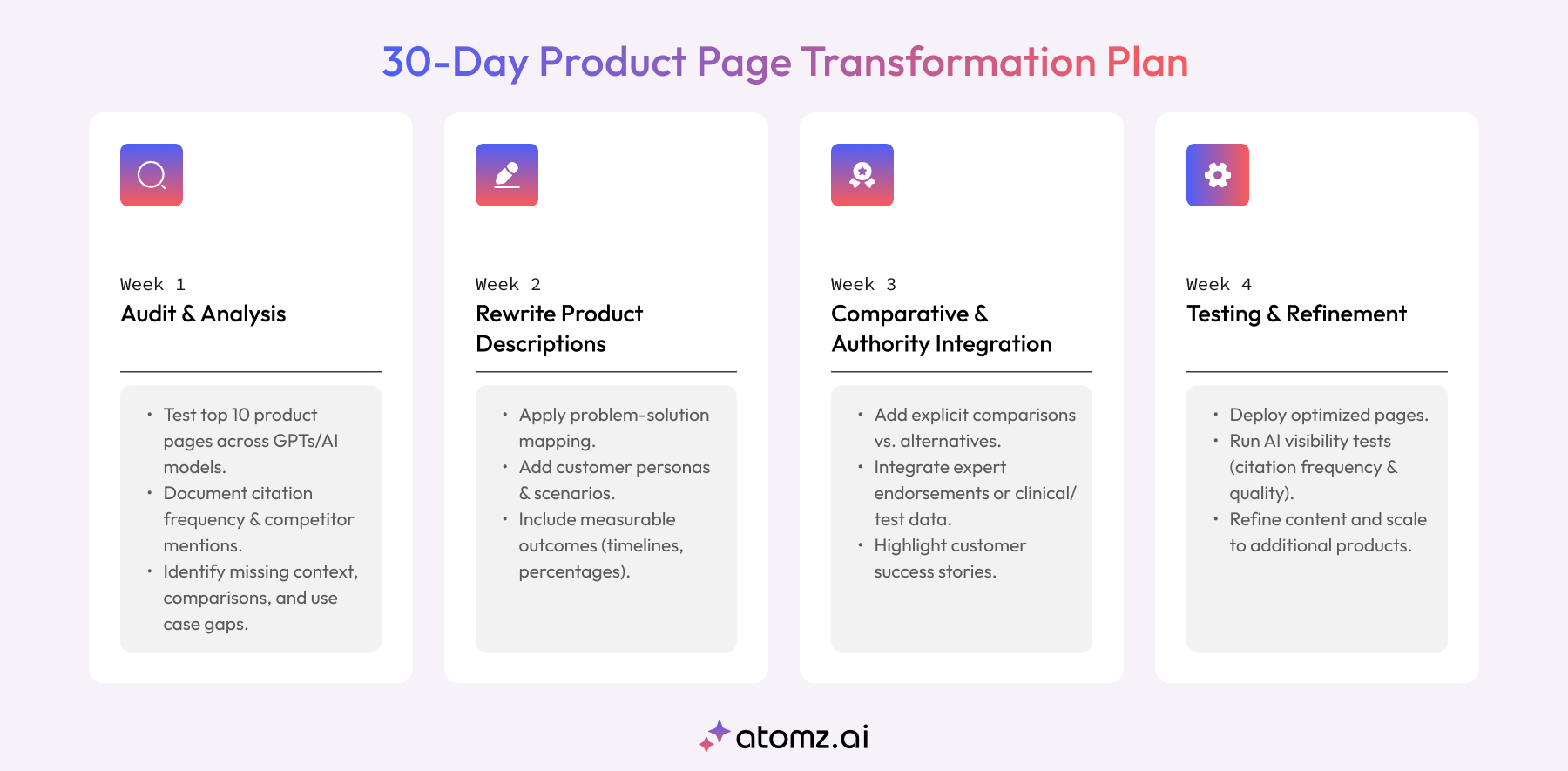
Problem: Applying traditional SEO keyword tactics to AI optimizationSolution: Focus on natural language and problem-solution clarity rather than keyword density
Problem: Attempting to appeal to everyone with vague languageSolution: Target specific customer types with precise problems and clear solutions
Problem: Listing what the product contains instead of what problems it solvesSolution: Lead with problems and outcomes, support with technical features
Problem: Describing products in isolation without comparison to alternativesSolution: Explicitly position against alternatives and explain specific advantages
Problem: Making claims without credible supporting evidenceSolution: Include expert endorsements, clinical data, and verified testimonials with specific outcomes
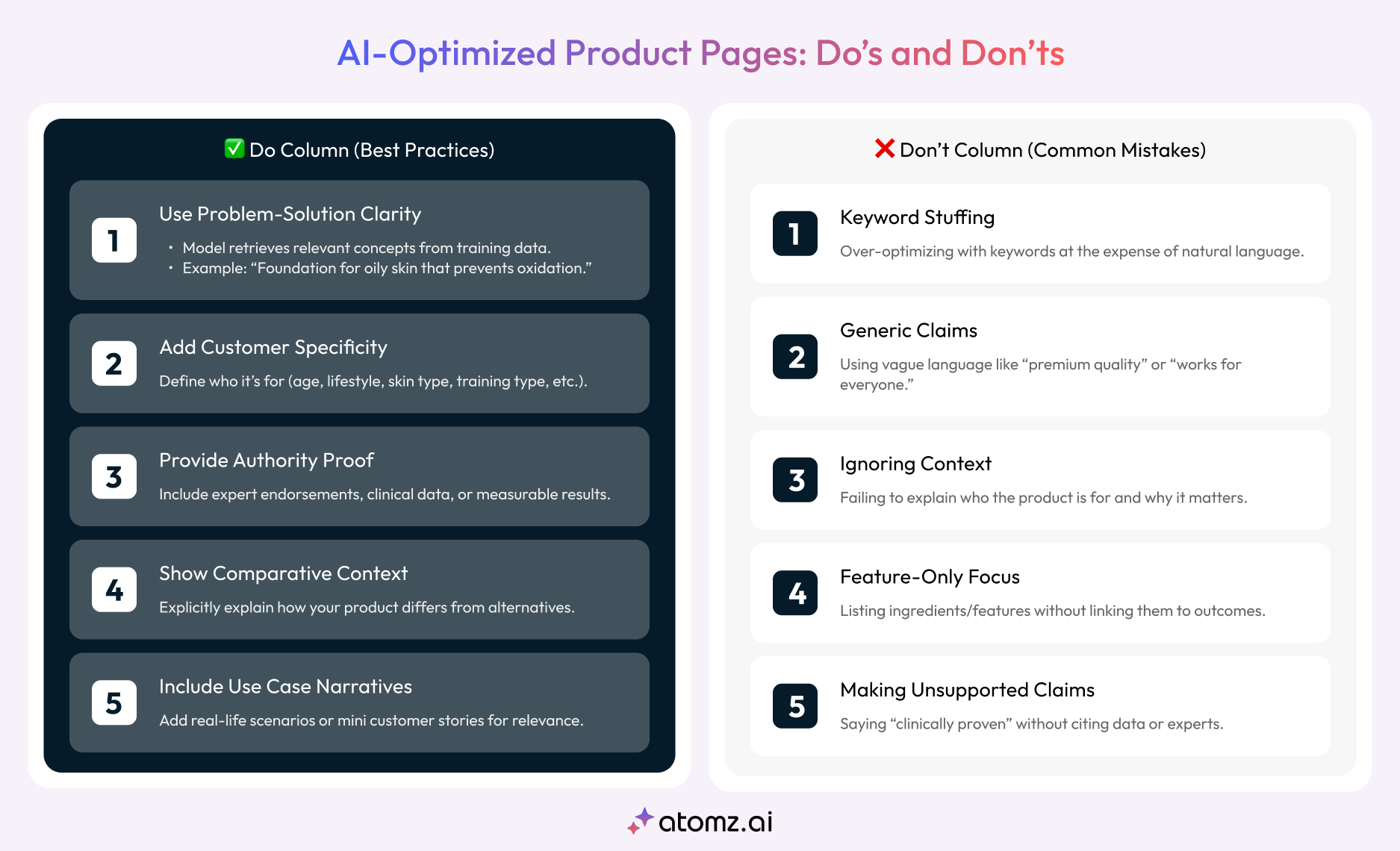
Visibility Assessment: Transform your product pages for AI discovery with our comprehensive audit tool to identify specific optimization opportunities.
Additional Resources:
Streamline your workflow, achieve more
Richard Thomas
Create buying intent instantly
Create buying intent before customers search. 25%+ conversion lift guaranteed.
Why Prompts Matter
AI Search That Converts 3x Better
Get the latest in AI-powered search, UX trends, and eCommerce conversions—straight to your inbo
No spam. Just powerful insights.
👉 Join thousands of growth-focused brands.

